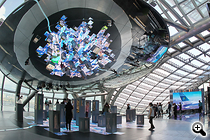 Recycling trashcans are everywhere you look at the Future Energy EXPO in Kazakhstan’s capital. For a region in which sprawling, smoldering, methane-emitting landfill sites are the norm, the message is a clear one: the future is green.
Recycling trashcans are everywhere you look at the Future Energy EXPO in Kazakhstan’s capital. For a region in which sprawling, smoldering, methane-emitting landfill sites are the norm, the message is a clear one: the future is green.
Sustainability and eco-friendliness are not obvious themes for a host nation whose economic fortunes have relied so heavily on a polluting and dwindling energy resource like oil.
But the amount Kazakhstan has splashed out on the event, billed as the cornerstone for a “center of excellence” to guide Central Asia to a more viable development path, suggests the agenda is being taken seriously.
For all this positivity, however, the event has at times risked being overshadowed by hapless messaging, lackluster organization and a creeping suspicion that the entire exercise may prove a giant waste of money.
Kazakhstan submitted its application to host the specialized international exposition to the Bureau International des Expositions in 2011. At a time when oil prices were averaging $100 a barrel, the potential price tag associated with hosting seemed eminently bearable.
Speaking at the opening of the Astana Economic Forum on June 16, President Nursultan Nazarbayev said preparing for the event cost $1.3 billion. This is a gentle accounting sleight of hand. Back in 2012, officials were predicting a $1.5 billion bill, then equivalent of around 225 billion Kazakhstani tenge. But for official purposes that $1.3 billion cited by Nazarbayev actually converts into 400 billion now-devalued tenge, so in local currency terms the overspend is notable.
The EXPO has involved the participation of 115 countries and a slew of multinationals. The brightest and best-attended pavilions belong to countries with well-established diplomatic ties to Kazakhstan.
In Malaysia’s pavilion, visitors are invited to use high-magnification binoculars to view flora and fauna in a simulated rainforest. In the Chinese offering, a 3D film takes viewers along on a mission with a “sun bird” and a young girl to save the girl’s ailing mother by finding sources of renewable energy.
“Mum, I was flying, I was actually flying,” exclaimed one boy after the film finished.
Genuinely captivating and interactive museums and educational displays remain something of a rarity in Central Asia, where musty and didactic Soviet holdovers prevail, so if nothing else, the EXPO is proving to be a hit for children.
And the government message about the exposition serving as a showcase to present Kazakhstan’s many doubtless appeals seems to have been accepted.
“I think hosting this EXPO was a fantastic idea,” 52-year-old Kanat Bazhkenov told EurasiaNet.org on the fringes of the eight-floor, 80 meter-diameter glass and steel spherical Kazakh pavilion that stands as the EXPO’s centerpiece. “Sure it was expensive, but look at all these tourists from China, Germany and France. They will come away from Kazakhstan with a great impression of us.”
Similarly, however, there is no disguising the irony of Kazakhstan, a nation where dirty coal-fired power stations account for the bulk of domestic energy needs, being the one to sell this message.
“Luckily, they will never see Temirtau!” Bazhkenov joked, name-checking a smog-swathed industrial town 200 kilometers south of the capital.
If Kazakhstan is to claim a larger stake in the global energy economy – Nazarbayev admits the country produces no more than 300 megawatts from renewable sources – it will likely be as a leading supplier of uranium for the nuclear power industry.
Indeed, nuclear power, controversial among many advocates of green energy, featured prominently in Kazakhstan’s pavilion and elsewhere at the EXPO.
When the EXPO opened, on June 10, journalists were herded toward a corporate panel on the topic hosted by atomic power giant Kazatomprom.
In a calculated dig at the Donald Trump administration, which had only just announced the withdrawal of the United States from the Paris climate accord, Rosatom chairman Alexei Likhachev waxed lyrical about the commercial prospects for cutting back on the use of oil and gas.
“No one today can deny the importance and unambiguity of our common obligations to reduce hydrocarbon emissions,” Likhachev said, while noting that nuclear power was “twice cheaper than wind, and three times cheaper than solar.”
Anthony DeAngelo, director of communications at the US pavilion, refused to say whether the Trump administration had played any role in its own message.
“This pavilion is really just focused on the innovation that has powered America since its very beginning and will continue to power it in the years to come,” DeAngelo told EurasiaNet.org, stressing “the strong bond between the US and Kazakhstani people.”
Any positives the EXPO may yield for Kazakhstan in the near and long-term have been threatened by the organizers’ tone-deaf approach to public relations.
On June 19, internet users in Kazakhstan began to publicize a blockage to the website of Foreign Policy magazine, which had published a scathing review of the EXPO that focused primarily on economic waste and purportedly poor visitor numbers.
EXPO chief spokesman Sergei Kuyanov compounded the scandal by calling the author of the piece, James Palmer, a liar and saying he had not even visited Kazakhstan at all. Palmer responded on Twitter with photographs showing stamps placed in his passport by Kazakhstani officials and an EXPO ticket stub.
Instead of seeking to quell the embarrassment, Information Minister Dauren Abayev rushed to Kuyanov’s defense, saying that he was simply under a great deal of stress.
Undeterred by the unfolding PR debacle, Kuyanov followed up by delivering an enraged, line-by-line critique of Palmer’s piece and accused the reporter of acting in collusion with political foes of President Nazarbayev.
The EXPO was not teeming with visitors on the opening day, and several accounts suggest numbers may have dropped off further since that time. In a statement that did more to confuse than clarify, Kuyanov said on June 19 that 167,884 people had already visited the EXPO’s “main attractions” since the opening, while more than a million had clicked through the turnstiles.
The focus on visitor numbers as an indicator of success has, in some respects, obscured an overall positive experience at the EXPO and genuinely popularizing the worthy environmental theme at its heart.
In a June 20 column for the regionally focused outlet Centre1.com, Almaty-based independent journalist Sergei Duvanov wrote caustically that the EXPO was primarily devised “to entertain patriotic ambitions and [show] that we, too, are not bastards, and can do something on the international level.”
“As for future energy, this is a second priority, a thematic background,” wrote Duvanov, a long-time government critic.
EurasiaNet.Org, 23.06.2017




